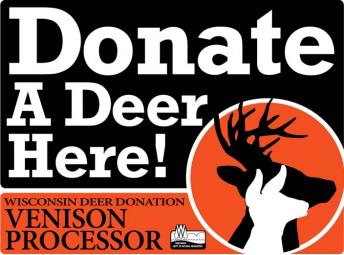






 Picture courtesy of Laurie FikeAs white-tailed deer gun season kicks off on November 19, hunters in Dane County will continue the tradition of harvesting deer for those in need of food. For years, hunters around the state have supplied local food banks with venison, contributing extra meat from the hunt. In the past few years, however, state-sanctioned donations have been down, leaving pantries wondering just how much venison they will have to share with families seeking assistance through 2012.
Picture courtesy of Laurie FikeAs white-tailed deer gun season kicks off on November 19, hunters in Dane County will continue the tradition of harvesting deer for those in need of food. For years, hunters around the state have supplied local food banks with venison, contributing extra meat from the hunt. In the past few years, however, state-sanctioned donations have been down, leaving pantries wondering just how much venison they will have to share with families seeking assistance through 2012.
As Food and Garden Division Manager at Dane County’s Community Action Coalition, Chris Brockel knows about the need for support in Wisconsin food pantries. He works with a number of facilities that provide nourishment and education about food to families in the county, and explained that while canned and boxed foods are a common donation in food pantries, fresh meat is more expensive and challenging to obtain.
“Meat items are very difficult for food pantries to come by. It’s not the type of thing you are going to get donated during a food drive,” said Brockel. Still, he stressed that meat is an important staple in the pantries.
“Any source of protein that we can get can be valuable. The venison is actually a very popular item in our food pantries,” Brockel said. “When it gets to be about [September], I already get calls from both food pantries and from individuals asking, ‘Where’s the venison?’ People look forward to it.”
History of Deer Donations
The Wisconsin Department of Natural Resources launched its state-issued Wildlife Damage Deer Donation program in 2000 to encourage hunters to contribute to the state’s food pantries by sharing venison with families in need. The program was modeled in part after a successful campaign founded in 1994 by Lee Dudek of the Green Bay, Wisconsin area.
By teaming up with local meat processors, Dudek established a way for hunters to simply drop off a deer for donation without dealing with treatment costs. He rationalizes that the process allows for hunters to control the deer population while also assisting fellow residents.
“It’s all about trying to help others out,” stated Dudek. “The best thing about the program is being able to enjoy what many of us enjoy, as far has hunting, and taking that activity to help others in need. That really is very gratifying.”
The Deer Donation program quickly became successful, and between 2000 and 2009, the State of Wisconsin recorded over 3 million pounds of venison donated to food banks in 56 counties. In 2009, 483 deer were donated to Dane County food banks to supply families with fresh meat.
Recent decreases in donations
In recent years however, there have been a decrease in donations statewide. During the 2010 deer season, only 419 deer were donated in Dane County, 64 less than the year before.
At the same time, the need for support at food pantries is ever increasing. Brockel explained that in 2007, the pantries he helps operate had visits from 85,000 households. By 2010, the number of visits increased to 132,000. He believes that the rise in numbers has occurred partly due to recent the economic downturn.
The economy could also be affecting donation rate as hunters might keep more venison for their own families and friends, or donate the meat directly to those in need.
“There’s a lot of deer, probably as many deer that are getting counted in the program, that are being donated directly by hunters. That’s been going in long before there was ever a program,” said Dudek.
Additionally, threats of chronic wasting disease in Dane County resulted in limited donations between 2002 and 2005, as officials worked on how to control the issue.
Laurie Fike, Wildlife Damage Abatement and Claims Program Specialist, at the Wisconsin Department of Natural Resources, predicted that this year’s harvest will be slightly down, but not the worst that it has been.
“It fluctuates year to year, depending on how many deer management units are in herd control and how many antlerless tags are available for sale. Last year was a little slow. The whole harvest was down and donations to the pantry kind of followed suit,” she said.
Since bow season began on September 17, Fike noted that venison donations have already started to trickle in, but a final donation total will not be known until invoices start coming in during January.
Those interested in donating should call ahead to a processor, asking if they participate in the donation program. Once dropped off, deer harvested in Dane County will be tested for chronic wasting disease before pantry distribution, and kept within the county they were shot.
Hunters can donate throughout the fall season, which wraps up statewide on January 8. For more information on donating, contact Fike at 608-267-7974.
|
|
|
Welcome to the Madison Commons, a website designed to provide news and information about all of Madison's neighborhoods and a crossroads for the discussion of community issues. The name comes from the idea of a village commons, a place for news, talk, debate, and some entertainment, too, that's open to everyone.
All rights reserved. Read more about the Madison Commons and its partners.

